Odoo is a powerful open-source ERP system, offering a suite of business applications that streamline operations across accounting, inventory, CRM, HR, and more. One of the most common questions companies ask when considering Odoo is: “How long does Odoo implementation take?” The answer depends on several factors including business size, customization needs, and implementation methodology.
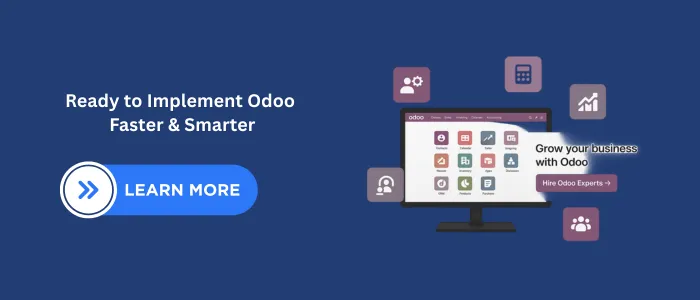
Introduction to Odoo Implementation Timeline
- Why Implementation Time Matters: ERP implementations are often resource-intensive, and a long timeline can affect business operations and project costs.
- Statistics on ERP Implementations: According to studies, over 75% of ERP implementations take longer than initially planned. Understanding what affects the timeline can help set realistic expectations and milestones.
1. Understanding the Odoo Implementation Lifecycle
The timeline for Odoo implementation can be broken down into several essential phases, each impacting the overall duration.
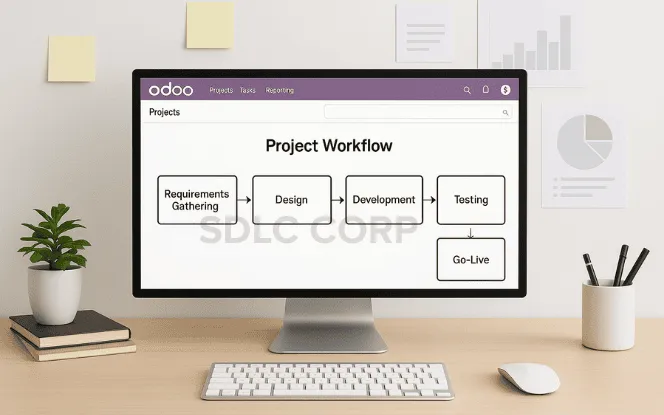
1.1 Requirements Gathering (1–2 weeks)
- Goal: Define your business processes, pain points, and functional needs.
- Activities: Stakeholder interviews, workflow mapping, user role analysis.
- Deliverables: Business Requirement Document (BRD), scope definition.
1.2 System Design & Planning (1–3 weeks)
- Goal: Translate requirements into a solution architecture.
- Activities: Module selection, process blueprinting, user permission matrix.
- Deliverables: Technical Design Document (TDD), timeline, and resource allocation plan.
1.3 Development & Customization (3–6 weeks)
- Goal: Customize workflows, UI/UX, and integrate third-party tools.
- Activities: Python and XML development, API integration, custom module development.
- Deliverables: Functional test environment, customization documentation.
1.4 Data Migration (1–4 weeks)
- Goal: Safely transfer and restructure your legacy data.
- Activities: Data cleaning, mapping, transformation scripts.
- Deliverables: Clean migrated datasets, validation reports.
1.5 Quality Assurance Testing (2–4 weeks)
- Goal: Validate system performance and user workflows.
- Activities: UAT (User Acceptance Testing), regression testing, security testing.
- Deliverables: Bug logs, test case reports, approval for go-live.
1.6 Training & Change Management (1–2 weeks)
- Goal: Equip users with hands-on knowledge.
- Activities: Instructor-led sessions, video tutorials, sandbox simulations.
- Deliverables: Role-based training manuals, feedback logs.
1.7 Deployment & Go-Live (1 week)
- Goal: Transition from staging to live environment.
- Activities: Final configuration, data freeze, DNS changes.
- Deliverables: Live ERP instance, go-live checklist completion.
1.8 Post-Go-Live Support (Ongoing)
- Goal: Stabilize the platform and provide user support.
- Activities: Monitor performance, resolve bugs, minor enhancements.
- Deliverables: SLA-based support tickets, patch release notes.
2. Factors Influencing Odoo Implementation Time
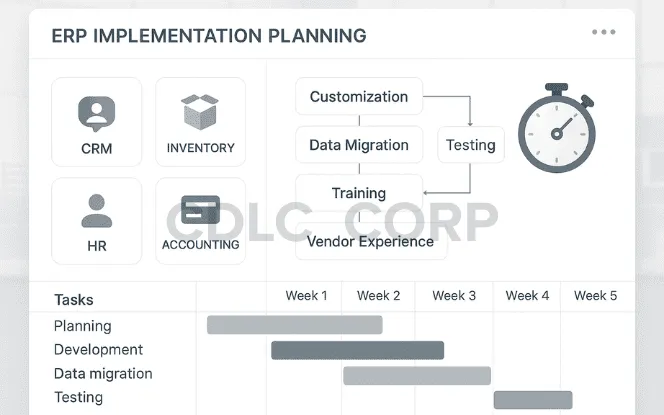
a. Scope of Implementation
Impact: The size and scope of the project—number of modules, users, and third-party integrations—significantly influence timelines.
- A single-module implementation (like CRM) can be completed in 3–4 weeks.
- A full ERP rollout involving Sales, Inventory, Manufacturing, HR, and Accounting may take several months.
How to Mitigate: Use a phased implementation strategy. Begin with the most critical modules and roll out additional ones after stabilization.
b. Level of Customization
Impact: Custom workflows, UI modifications, and added features extend both development and testing time.
- Using Odoo’s built-in features speeds things up, while heavy customization increases duration and cost.
How to Mitigate: Focus on essential customizations. Where possible, adapt business processes to Odoo’s native features.
Key Stat: Heavily customized projects take up to 40% longer than standard configurations. (Panorama Consulting)
c. Data Migration Needs
Impact: Migrating from legacy systems can be time-consuming especially with unclean or unstructured data.
- Poorly formatted data or multiple sources can add weeks to the process.
How to Mitigate: Perform a data audit early. Clean and prepare data before the migration phase begins.
d. Testing and Quality Assurance
Impact: Inadequate testing leads to post-launch issues that delay operational readiness.
- Complex configurations or integrations require more thorough testing.
How to Mitigate: Allocate dedicated time for end-user testing and QA. Use a checklist or test scripts to ensure coverage.
e. User Training and Adoption
Impact: Without effective training, teams struggle to adopt the new system, delaying productivity.
- Large teams or multiple departments require segmented and role-specific training.
How to Mitigate: Identify power users for each department. Conduct hands-on training and share easy-to-follow guides or videos.
f. Vendor or Consultant Experience
Impact: Inexperienced partners may mismanage planning, causing avoidable delays.
- Expert consultants streamline processes and foresee integration or migration challenges.
How to Mitigate: Choose a vendor with Odoo-specific experience and success in similar industries.
Table: Average Odoo Implementation Times by Project Scope
Project Scope | Modules Involved | Average Duration |
Basic Setup | CRM, Sales, Inventory (Standard) | 4-6 weeks |
Medium Implementation | CRM, Sales, Inventory, Accounting | 8-12 weeks |
Full ERP | Full suite (customized) | 12-20+ weeks |
3. Typical Timeline Estimates for Odoo Implementation
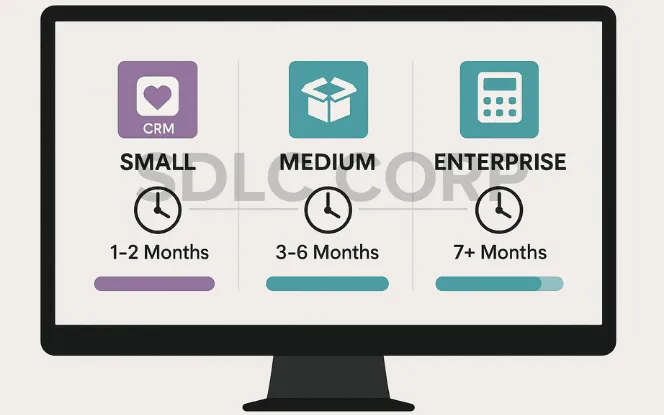
Small Businesses (Single Module)
- Scope: Implementation of one basic module such as CRM or Sales.
- Timeline: 4-6 weeks
- Key Activities: Requirements gathering, Module configuration with minimal customization, testing, Basic data import, and End user training.
- Challenges: User adoption and ensuring a seamless switch from manual processes or simple tools like spreadsheets.
Medium Businesses (Multi-Module Setup)
- Scope: 2–4 standard modules (e.g., Sales, Inventory, Accounting).
- Timeline: 8-12 weeks
- Key Activities:
a. System design and planning across departments
b. Moderate customization and integration (e.g., payment gateways, shipping APIs)
c. Data migration and multi-user access setup
d. Role-based training
- Challenges: Handling data from older systems, departmental coordination, and testing across multiple modules.
Large Enterprises (Full ERP Deployment)
- Scope: Full suite (Sales, Inventory, HR, Accounting, Manufacturing, and more), often with heavy customization and third-party integrations.
- Timeline: 12-20+ weeks
- Key Activities:
a. End-to-end workflow customization
b. Integration with external systems (e.g., eCommerce, legacy ERPs, analytics)
c. Extensive UAT and multi-departmental training
d. Performance tuning and go-live planning
- Challenges: Managing multiple stakeholders, change resistance, and ensuring scalability across business units..
4. Best Practices for Reducing Odoo Implementation Time
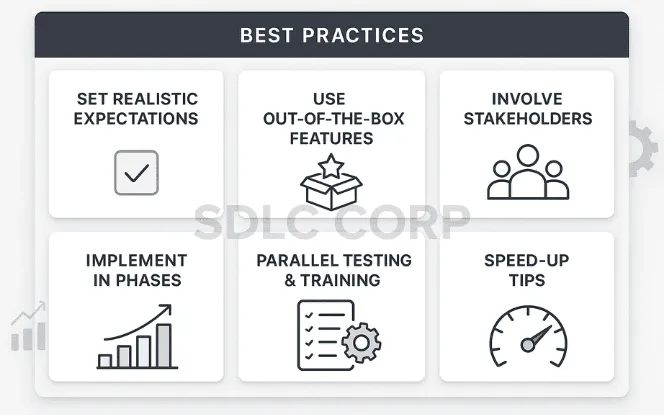
Implementing Odoo efficiently requires more than just technical configuration—it demands a well-thought-out strategy, cross-functional collaboration, and discipline in execution. Below are some of the most effective practices used by successful ERP project teams to reduce timelines without sacrificing quality.
4.1. Set Realistic Expectations :
- Why it matters: Unrealistic timelines often lead to rushed work, poor testing, and user dissatisfaction.
- Assess your team’s availability, technical readiness, and internal bandwidth.
- Build a project timeline that considers potential bottlenecks like data migration and stakeholder approvals.
- Include buffer time for iterations and post-go-live stabilization.
4.2. Leverage Odoo’s Out-of-the-Box Features :
- Why it matters: Customization can significantly delay implementation and increase long-term maintenance costs.
- Odoo’s standard modules already support many best-practice workflows across industries.
- Use built-in tools like automated invoicing, inventory tracking, and project Gantt views to avoid rebuilding what already exists.
- If a feature is “nice-to-have,” consider pushing it to a post-launch enhancement phase.
4.3. Involve Key Stakeholders Early :
- Why it matters: The people using the system know the business workflows best—and their buy-in is critical for adoption.
- Engage team leaders and department heads during the requirement gathering and design stages.
- Early involvement reduces revision cycles, ensures better module alignment, and builds internal champions for adoption.
4.4. Implement in Phases :
- Why it matters: Phased rollouts minimize risks and allow for faster realization of value.
- Start with core business functions like Sales, CRM, or Inventory.
- Once the system stabilizes, expand to additional modules such as Accounting, HR, or Manufacturing.
- This approach simplifies testing, change management, and training.
4.5 Conduct Parallel Testing and Training
- Why it matters: Waiting to finish development before starting training can extend your go-live date unnecessarily.
- As modules are completed, begin user testing and training simultaneously.
- Encourage hands-on sandbox usage during training to speed up onboarding.
- Assign dedicated trainers or create short training videos for repetitive tasks.
4.6 Top Tips to Speed Up Odoo Implementation :
- Define and document clear requirements before development begins.
- Minimize unnecessary customizations—stick to essentials .
- Use agile project management to work in sprints with regular feedback loops.
- Communicate regularly with stakeholders to align expectations and address blockers early.
5. Odoo Implementation Timelines – Real-World Scenarios
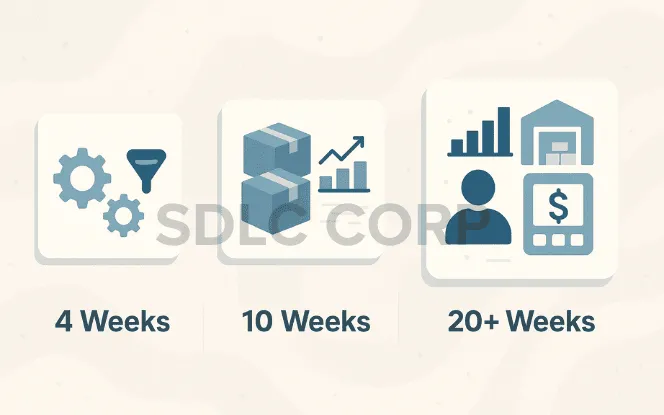
To provide a clearer picture of how long an Odoo implementation might take, here are real-world inspired examples based on different project scopes. These scenarios show how timeline, challenges, and scope vary by business size and complexity.
Example 1: Small Business – CRM Implementation
- Company Type : Regional Retail Chain
- Modules Implemented : CRM, Sales
- Implementation Timeline : 4 weeks
- Overview :
A small retail business looking to improve customer relationship management and streamline their sales process chose Odoo CRM and Sales modules for implementation. - Challenges Faced: :
User hesitation in switching from manual tracking to a structured CRM.
Initial difficulty in organizing scattered customer data for migration - Result : A smooth go-live within a month, improved sales pipeline visibility, and better customer follow-ups using automated reminders and sales stages.
Example 2: Medium-Sized Business – Multi-Module ERP Setup
- Company Type : Manufacturing SME
- Modules Implemented : Inventory, Sales, Accounting
- Implementation Timeline : 10 weeks
- Overview :
This manufacturing business needed a more integrated solution to manage warehouse operations, invoicing, and sales workflows in one platform. Challenges Faced :
Unstructured historical data required extensive cleaning and mapping
Staff adjustment to digital workflows after years of semi-manual processes
Synchronization issues with existing accounting practices initially
Result :
Successful go-live with improved inventory turnover accuracy, centralized invoicing, and consolidated reporting. Team adoption increased within the first month post-deployment.
Expert Odoo ERP Solutions Provider
Working with experienced Odoo consultants, like our certified team at SDLC Corp can cut weeks off your timeline and help you avoid costly missteps.
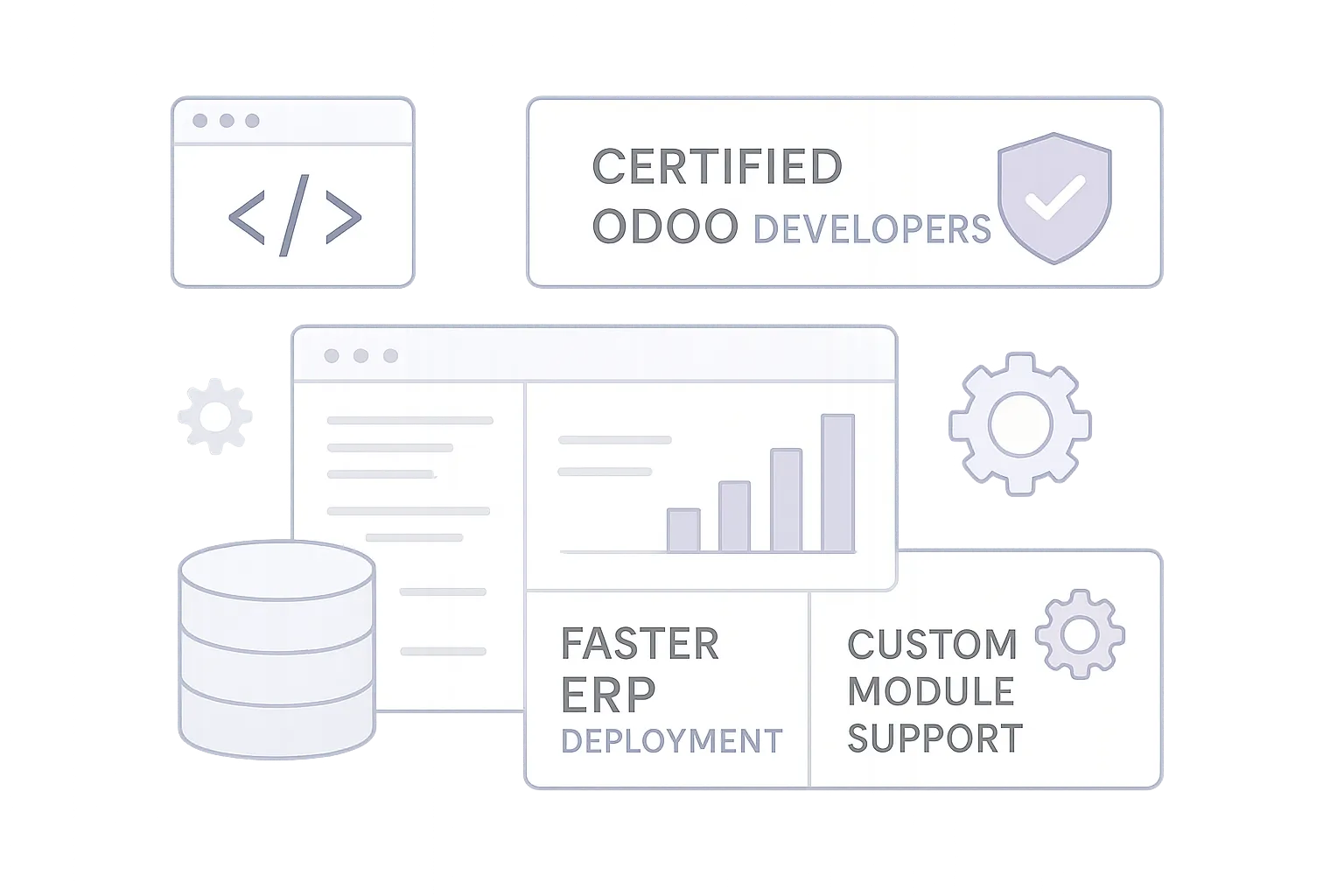
Conclusion
The timeline for Odoo implementation depends on your business size, customization needs, and readiness—but with the right strategy, even complex rollouts can stay on track.
Focus on clear project scoping, essential features, early stakeholder input, and expert support to reduce risks and boost adoption.
Whether you’re starting with a single module or scaling company-wide, a thoughtful approach turns Odoo into a long-term growth engine.
Also Read:
FAQs
How long does an Odoo implementation typically take?
The duration can range from 4 weeks to 6 months, depending on your project size and complexity.
- Small businesses using standard Odoo modules (like CRM or Sales) can implement in 4–6 weeks.
- Mid-sized businesses with moderate customization typically need 8–12 weeks.
- Larger enterprises with complex workflows, integrations, and heavy customization may require 16–24+ weeks.
What are the main factors that affect the implementation timeline?
Several key elements influence how long an Odoo project takes:
- Number of modules (e.g., Sales, Inventory, Accounting, HR)
- Extent of customization required
- Complexity of data migration from legacy systems
- Third-party integrations (eCommerce, logistics, payment gateways)
- Size of the user base and training requirements
- Availability and involvement of internal stakeholders
Can Odoo be implemented faster for small or simple businesses?
Yes, absolutely. If your business has a clear workflow, fewer users, minimal integration requirements, and uses Odoo’s out-of-the-box features, implementation can often be completed in 3–5 weeks.
What is the standard process for implementing Odoo ERP?
Odoo implementation typically follows a structured lifecycle:
- Requirement gathering
- System design
- Customization
- Data migration
- Testing
- Training
- Go-live
How can I speed up the Odoo implementation process?
Here are some proven ways to reduce your go-live timeline:
- Define your requirements clearly before starting the project
- Minimize customizations—stick to native Odoo features when possible
- Work with a certified Odoo partner for expertise and best practices
- Ensure proactive communication between your internal team and your implementation partner
- Adopt a phased rollout—launch essential modules first, expand later
What’s the difference between standard and customized Odoo implementations?
Standard implementation uses Odoo’s out-of-the-box features with minimal changes.
Customized implementation involves tailoring workflows, modules, or integrations to fit your unique business processes.
While standard setups are quicker and cost-effective, customizations offer flexibility for more complex needs—but require more time and testing.
Do I need technical expertise to implement Odoo?
Not necessarily. While having technical resources helps, many businesses successfully implement Odoo using experienced consultants or certified partners. If you’re using Odoo Studio and standard modules, minimal technical skills are needed. For complex workflows or custom development, partnering with a technical expert is highly recommended.
What happens after Odoo goes live?
After go-live, your focus should shift to:
- Monitoring system performance
- Fixing post-launch bugs
- Providing user support
- Training new employees
- Planning future module rollouts or enhancements
Ongoing support, performance tuning, and SLA-backed maintenance ensure your ERP continues to align with business growth.



